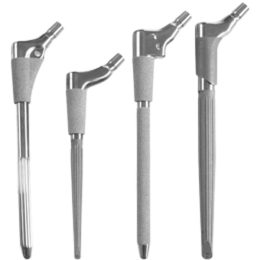Product Description
A mid-stem modular junction allows for the selection of a proximal body design independent of the choice for a distal stem design. The mid-stem design also allows for completely independent proximal/distal implant positioning and component sizing. This enables a wide variety of bone conditions to be accommodated that are often not fully revealed until the time of surgery. ZMR Implants are available in either a standard junction design or with an extra large junction (XL junction) for larger patients or for those patients whose femur may not provide adequate proximal support.
The system also accommodates a number of fixation philosophies, including distal fixation, proximal fixation, and extensive porous fixation.
The ZMR Hip System includes three distinct porous body styles.
Straight and bowed spline stems are available in up to three stem lengths, in six diameters, to optimize patient fit. The coronal slot makes the distal stem more flexible, allowing for easier stem insertion.
Straight and bowed porous stems are available in up to three stem lengths, in eight diameters, to optimize patient fit. The Porous Stems are coated with plasma-sprayed Tivanium® 6Al-4V Alloy to allow for biological fixation.
The corundumized, splined taper stem is designed to provide distal fixation that transmits axial, torsional, and bending loads to the adjacent bone.
Please refer to the package inserts for complete product information, including contraindications, warnings, precautions, and adverse effects.
Product Brochure
Indications
Contraindications
- Use of this device when a less invasive procedure would be sufficient
- Skeletal immaturity
- Loss of abductor musculature in the affected limb
- Poor bone stock (e.g., steroid-induced metabolic bone disease)
- Poor skin coverage around the hip joint
- Neuromuscular disease (e.g., Charcot’s joint) in the affected limb






